Contents
Even 3-4 years ago, when the jig-rig was just gaining popularity, many assured that the catchability for this rig was 2-3 times higher than others. Now the boom has died down, and there are more professional opinions about the jig rig, different from the original ones. About the wiring technique, assembly rules, as well as the strengths and weaknesses of this equipment in our article.
What is a jig rig
A jig rig is a type of spinning rig with silicone bait designed for catching predatory fish.
This fishing equipment consists of an elongated sinker and an offset hook fastened together with connecting elements (this can be a winding ring, swivel, carabiner, or a combination of them). In addition to silicone bait, it is quite appropriate to use a foam rubber fish.
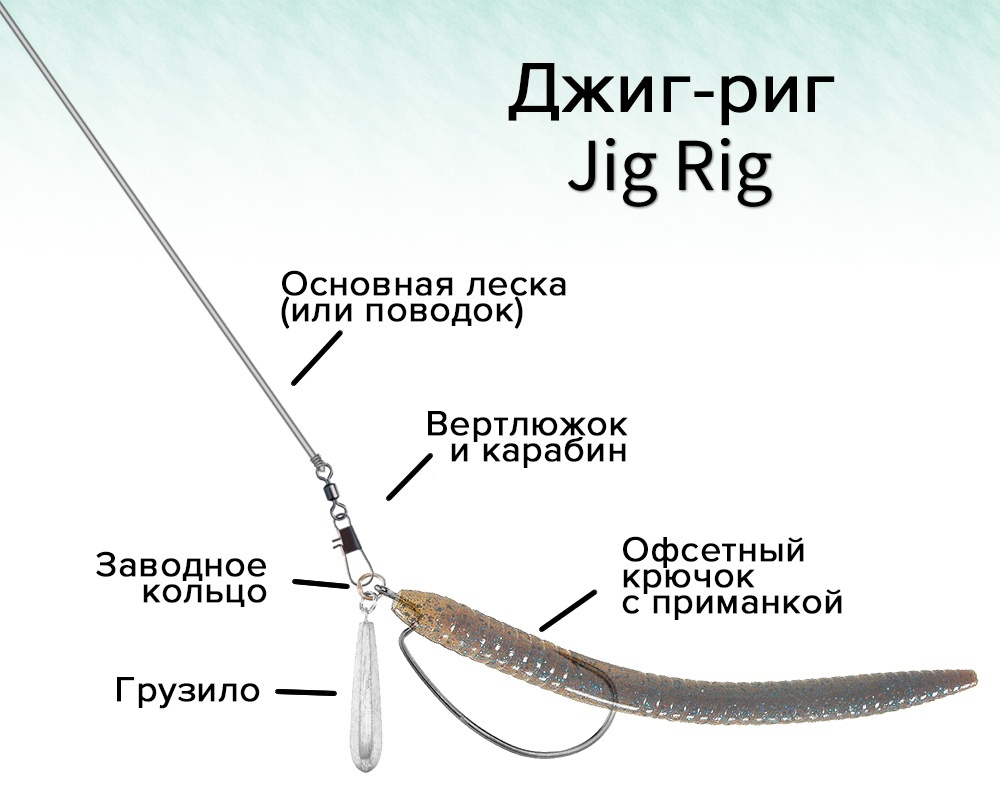
Where and when applied
It is believed that this design was invented in the United States for catching largemouth bass (trout perch). Its use gave the bait increased permeability in dense thickets of bottom grass or in the crown of a flooded tree.
Unlike American inventors, who use jig-rigs only for fishing in ponds with thickets and snags, our fishermen also use this equipment for heavily silted bottom, as well as on sandstone and shell rock.
It is worth noting that this type of mounting is ideal for fishing from the shore in still water or at very low current speeds.
According to many reviews, the best time of the year to fish with a jig rig is late autumn. At this time, fish accumulate in snags and pits, and a layer of fallen leaves forms at the bottom.
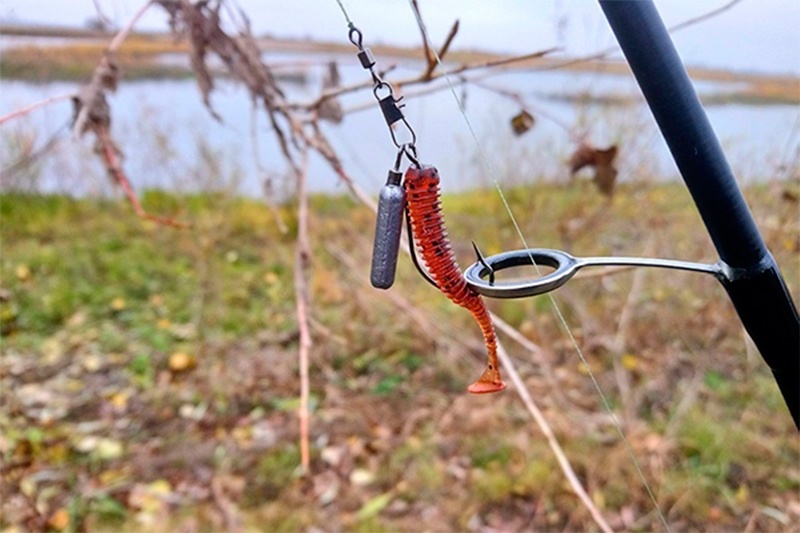
Silicone on a jig head or hinged mounting on a cheburashka collects pricked leaves already at the beginning of wiring, but a jig rig (only when using an offset hook) allows you to avoid this, since only the end of an elongated sinker slides over the leaves.
What kind of fish can you catch
In the name of this type of installation, it is not in vain that the word “jig” is used in front: this immediately determines that the equipment is used for bottom fishing of any predatory fish. But since bass (trout perch) is not found in Russian reservoirs, jig-rig fishing for our spinningists means catching pike, asp, pike perch, bersh, perch and catfish. Sometimes you come across chop, ruff, burbot, snakehead and even chub.
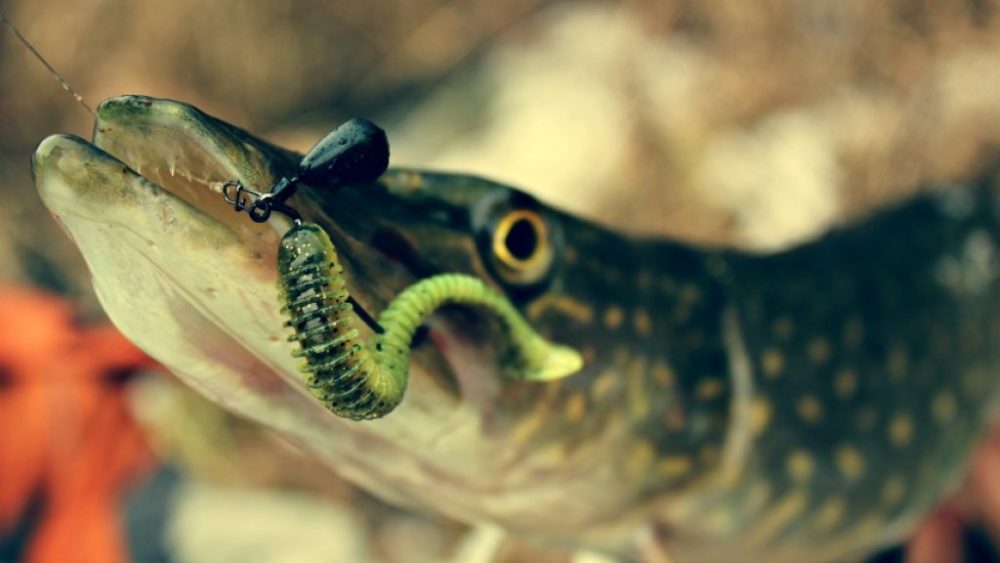
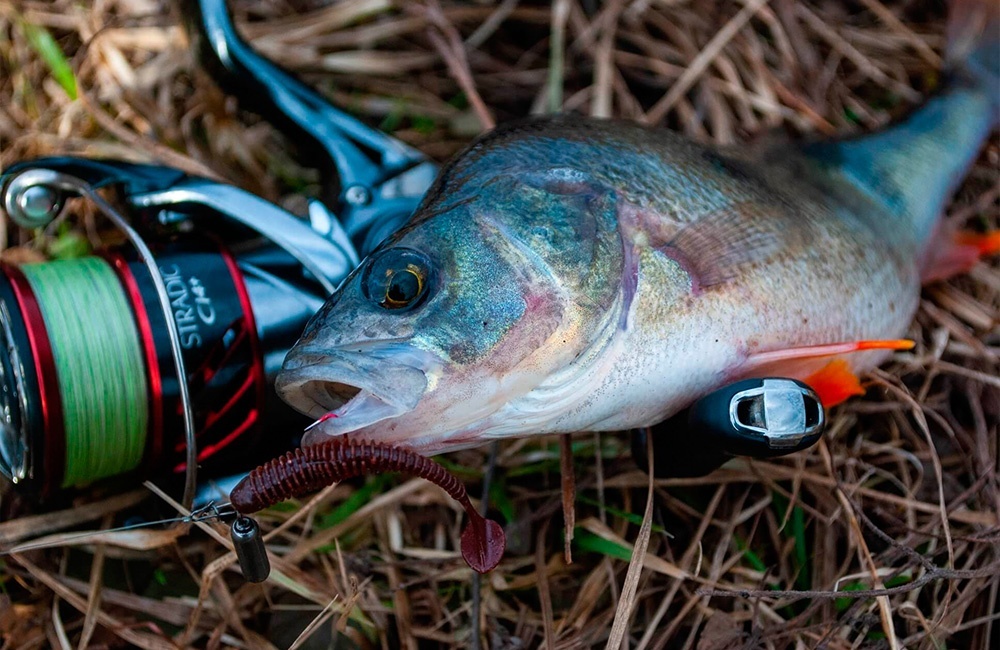
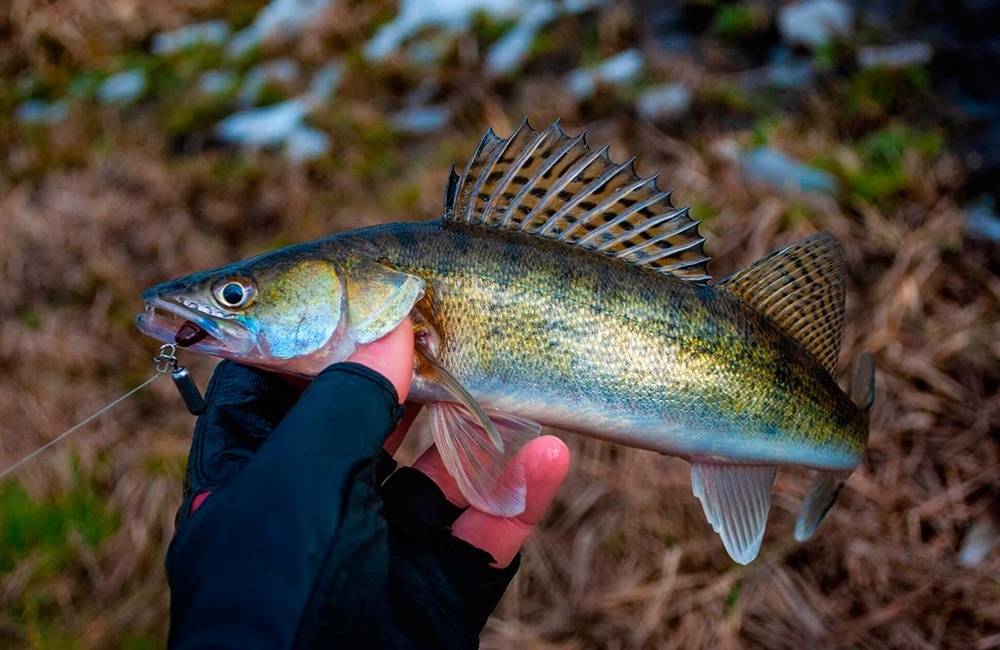
Advantages and disadvantages
The most important advantage of this rig is its excellent aerodynamic qualities, which increases the casting distance from the shore in comparison with silicone on a jig head and cheburashka. However, the range appears only if the cross section of the bait does not exceed the cross section in front of the flying load.
There are other advantages:
- Ease of assembly of this type of mounting.
- Greater variability in the animation behavior of the silicone bait due to the increased degrees of freedom in the hinges.
- Very low “hooking”, which allows you to pass not only thickets, but also snags.
The jig rig also has disadvantages:
- when using a stick sinker during wiring, the bait does not have optimal positioning (the hook does not have a fixed position);
- due to the sinker falling on its side while touching the ground and swinging with a sharp cord tension, the jig turns out to be incorrect and sloppy;
- the use of swivels, winding rings and fasteners reduce the strength of the equipment.
Installation of equipment
The classic version of this type of installation includes:
- elongated sinker with a loop;
- 2 winding rings;
- offset hook;
- silicone bait (usually a vibrotail).
An offset hook with a silicone bait and a sinker through the second winding ring are attached to the main winding ring, and a leash is also attached.
In addition to the classic version, spinningists also use other, slightly modified mounting options:
- A cord, a silicone bait on an offset hook and a sinker on a swivel are attached to the central winding ring.
- Instead of a central winding ring, a leash with a carabiner attached to a cord is used, on which an offset hook with silicone and a weight on a swivel are put on.
It is very important that a hook is put on the fastener first, and then a sinker. During the fight, the pike shakes its head, and the clasp can unfasten. If there is a sinker in front: it will rest against the carabiner, and will not let the hook fly off. If the opposite is true, the hook will turn out, slip off the clasp, and the trophy will be lost.
You can either do the installation yourself or purchase it ready-made in a specialized fishing store, including on Aliexpress, which will be quite relevant for beginners.
Jig rig fishing technique
Consider the features of spinning fishing using this equipment.
Selection of cargo and bait
The shape of the sinker can be different: drop-shaped, cone-shaped, multifaceted or in the form of a banana. You can also use drop shot sticks.

Photo: Weight for jig rig, varieties
For everyday fishing, lead weights are suitable, but for competitions you can be generous with tungsten sinkers. They pierce the wind better, and with the same weight, they are 45% smaller in volume than lead ones.
Since the main advantage of a jig rig is its range, therefore, so that the cross section of the bait does not exceed the cross section of the load, vibrotails, worms and slugs are best suited as silicone.
Some spinningists still prefer “foam rubber”, putting a bait fish on a double hook, but such a jig rig is most often used in non-littered reservoirs, as well as on a muddy, sandy or shelly bottom.
Sinkers, baits, and hooks are chosen in proportion to the predatory fish that they are trying to catch.
Wiring methods
Thanks to the use of stick sinkers in this type of rigging, the main hauls used in the classic jig (aggressive, stepped, demolition, pelagic jig and jumping over the bottom) are supplemented by playing with bait in one place and hauling along the bottom.
Playing with silicone in one place effective when catching active predators hiding between snags, in pits and thickets. An interesting animation is achieved by lightly twitching the jig rig with the tip of the rod and then tilting the long sinker on its side. It is at this moment that the bite usually occurs.
Wiring on the bottom suitable for lethargic and apathetic individuals. While the tip of the sinker-stick during movement raises a strip of turbidity from the bottom, the bait itself goes above it in clear water. From the outside, it seems that a small fish is chasing something that is quickly crawling along the bottom.
In order to reduce the speed of wiring, a special sinker-ski is used, resembling a flattened drop.
Even classic jig wires with jig rigs have their own characteristics. When fishing with stepped wiring on a stubbly or overgrown bottom, due to the collapse of the sinker-sticks, silicone works better on a pause.
Also with pelagic jig, while pulling the rig in the water column, the silicone lure plays much more interestingly, being above the sinker, and not following it.
Micro jig rig
This method is used to catch small predators and even relatively peaceful fish, the size of silicone baits is limited from two to five cm, and the weight of the weights is from one to six grams. Offset hooks and carbines are also chosen in small sizes.
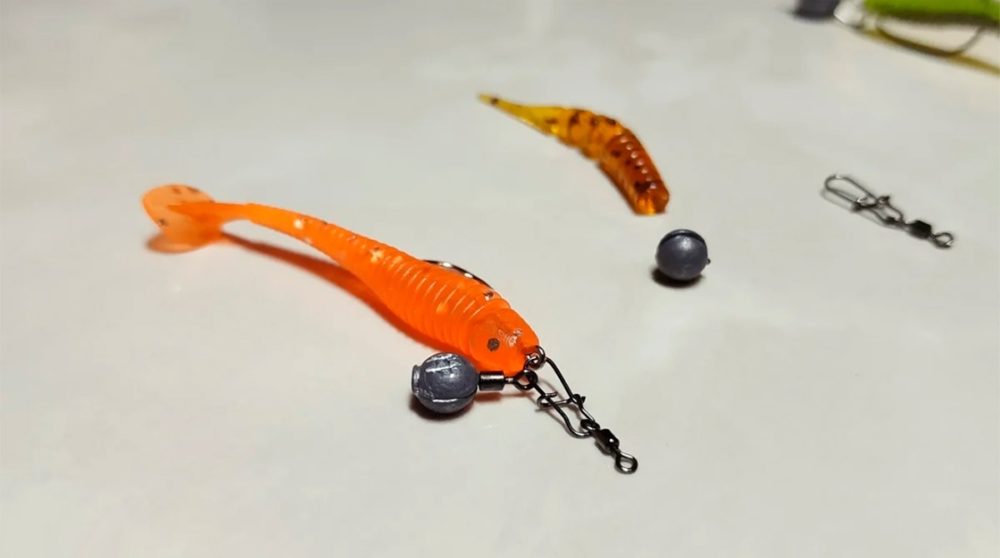
With autumn colds, the water becomes more transparent, and the fish move away from the shore. In order to cast a lightweight micro jig rig over a longer distance, a jig rig type of mounting is just right.
Since it is problematic to find sinkers with a swivel for such micro equipment, craftsmen clamp a sinker-shot (1-2 g) on one of the rings of a miniature swivel, which is sold in a set for fishing with a float. Further installation is no different from a full-fledged jig rig.
Pike fishing on a jig rig, equipment features
This type of mounting is indispensable when catching this predator. Grass pike weighing 1-2 kg usually hide in thickets on shallow tables, while larger specimens prefer bottom blockages of stones and snags.
It is clear that in order to hunt a large predator, you need the appropriate tackle and equipment:
- reliable rod (2,5-3 m) with a fast blank action and a test of at least 15 g;
- multiplier or inertialess reel with a small gear ratio and a spool size of at least 3000;
- braided fishing line about 0,15 mm thick.
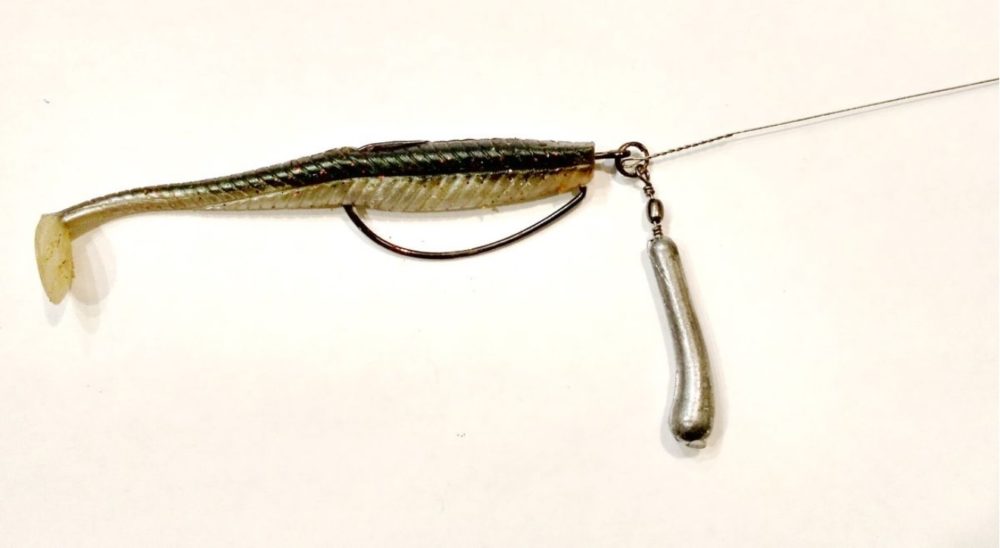
Photo: Pike jig rig
To mount the jig rig you will need:
- semi-rigid (tungsten) or, ideally, rigid (steel) Kevlar leader at least 40 cm long (when attacked from the side or swallowed in pursuit, the cord will be cut due to a small leader);
- clockwork rings, carabiners, swivels and offset hooks made of thick wire of the highest quality that can withstand maximum loads.
The size of silicone baits is selected depending on the expected size of the future trophy.
Big pike will not chase small fish. Therefore, to catch a predator weighing 3-5 kg, you need a silicone vibrotail at least 12 cm long, a sinker weighing at least 30 g and an appropriately sized offset hook marked 3/0, 4/0 or 5/0.
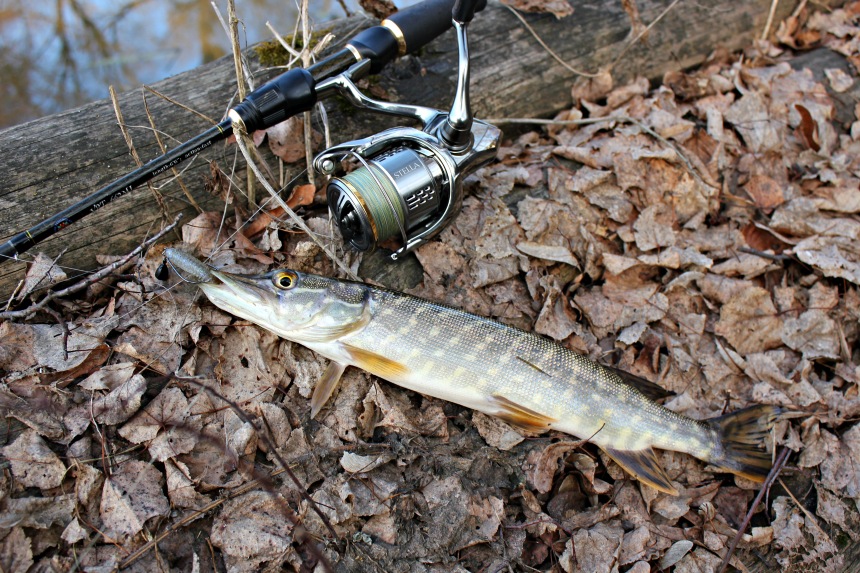
I would like to note that, unlike the perch, the pike does not pay attention to the “edible rubber” – it is more attracted to the game of the bait.
As can be seen from the article, this type of installation, like all others, has its drawbacks in addition to its advantages. It is important that the spinning player understands in which situations this equipment will show its best qualities, and in which its shortcomings can be eliminated by skillful wiring and selection of high-quality fittings.










